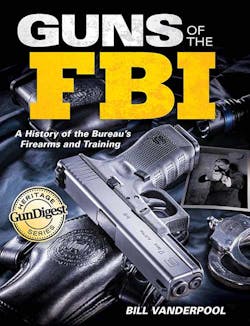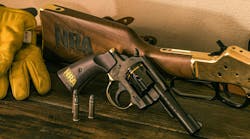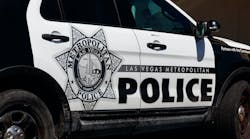As a former FBI firearms instructor and SWAT team member, I was excited to get my hands on a copy of this new book. Written by my former colleague, Bill Vanderpool, it’s a comprehensive look at the weaponry and training of one of the country’s most respected law enforcement agencies.
One of the more important events that created a new firearms and training paradigm for the FBI was the 1986 shootout in Miami, Florida. In that intense incident involving a traffic stop on a vehicle containing two bank robbers, an unbelievable gun battle ensued that resulted in the deaths of both subjects and two agents. Four other agents were wounded. That day was the catalyst for sweeping changes in the Bureau's policies regarding firearms, ammunition, and training. That one incident caused the FBI to become less parochial in its thinking, as it sought to find solutions outside of the agency. Something that had previously rarely happened.
Guns of the FBI is a book that is not only a history/reference tome, but it’s an interesting read that has a chronological flow that allows the reader to be both informed and entertained. Starting in 1934, when Director Hoover began accepting agents with other than accounting degrees, Vanderpool writes about several early FBI luminaries such as Frank Baughman, former Texas Ranger Doc White, and former Oklahoma City police officer, Delf Albert “Jelly” Bryce, who was an amazing shot and was known to have killed more than a half dozen thugs.
The book then covers the gangster era of the 1930s, when violent crime rose and often crossed state lines which gave the FBI jurisdiction to investigate. This was a time when criminals became famous and even idolized. Baby Face Nelson, Pretty Boy Floyd, Machine Gun Kelly, and Al Capone became household names. It was also a time when the Bureau suffered what’s remembered as the Kansas City Massacre, where an agent and two police officers were killed by gangsters armed with Thompson submachine guns. Fearing his agents were under armed, Director Hoover began arming his men with Thompson submachine guns (Tommy Guns) and Colt 45 special automatic pistols with ball ammo. There is a separate chapter on the Tommy Gun.
In the early days of firearms training, agents reported to various military bases around Washington, D.C. for firearms training. Eventually, the Army was no longer able to accommodate them. So, in 1934 an agreement was struck with the Marine Corps base at Quantico, Virginia. To this day a massive complex at Quantico houses the FBI Academy, Crime Lab, firearms ranges, Hogan’s Alley, and other facilities.
There is a chapter on the revolvers agents used to be issued, mostly .38 caliber Colts and Smith & Wessons . Agents were also allowed to purchase their own weapons, which were mostly smaller frame and shorter barrel weapons than their duty gun. If an agent had a personally owned weapon, he was required to qualify with it to carry it. Fifty years later the revolvers are no longer issued; the semi-auto pistol is the issued sidearm. Many new agents today have no idea how to operate or clean a revolver.
I’ve always considered the Firearms Training Unit (FTU) to be a special place, and its inhabitants to possess special powers. The men and women assigned there were virtual encyclopedias when it came to guns, ammo, and training. One of the icons of the unit was George Zeiss (Big George). He was a field agent until 1954 when he became head of FTU. He was well known for his “trick shooting” demos, and most notably for being one of the agents assigned to return James Earl Ray back to the United States.
Ray was eventually convicted for the murder of the Reverend Martin Luther King. The chapter on FTU is a wealth of information regarding weaponry and course development.
The book chronicles the development of combat firearm courses using pepper poppers, dueling trees, and steel head plates. Also, how to utilize cover and concealment and shooting from behind barricades and from vehicles. Eventually, the Bureau introduced technology into its training repertoire, adopting laser-equipped revolvers and vests. They began training their agents with FATS machines, and eventually adopted “shoot-don’t shoot” scenarios with state-of-the-art simulators. SWAT Teams utilized tire houses using live-fire to train, and practiced assaults on actual buses and airplanes.
One of the most visited and talked about venues at the FBI Academy is Hogan’s Alley. A self-contained mini-city, it has a variety of buildings—a bank, restaurant, hotel, drug store, movie theater, and brownstone apartments. It’s a place where agents put their classroom studies to work, a practical application of their skills and abilities. The Practical Application Unit has its own fleet of cars and utilizes paid role players that serve as bad guys and gals. This is also where the FBI trains its violent crime task force teams, consisting of police officers and agents from other agencies. Adjacent to Hogan’s Alley is a defensive driving training range where new agent trainees practice high speed pursuit and felony traffic stops.
There are thirty chapters in this historic look at the FBI. In addition, there are addendums containing courses and training manuals, ammunition test sheets, and other interesting topics. A plethora of photos, both old and new, compliment this excellent history book. For law enforcement and gun aficionados, as well as history buffs, this book is a great read. I’m proud to have it as part of my personal library. Well done, Bill Vanderpool!
Stay Safe, Brothers and Sisters!



